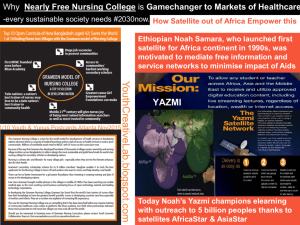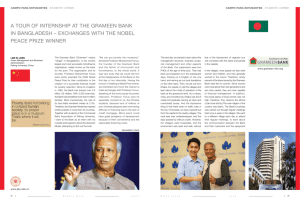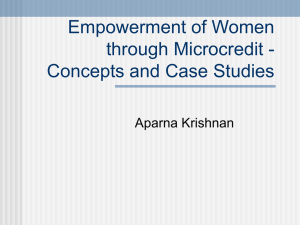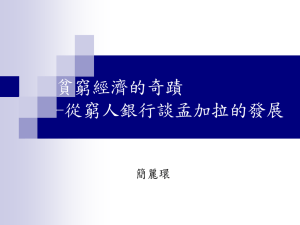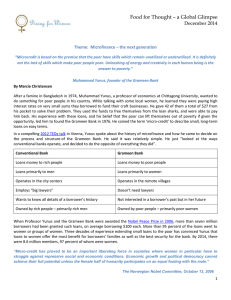Grameen Trust - Build-Operate
advertisement
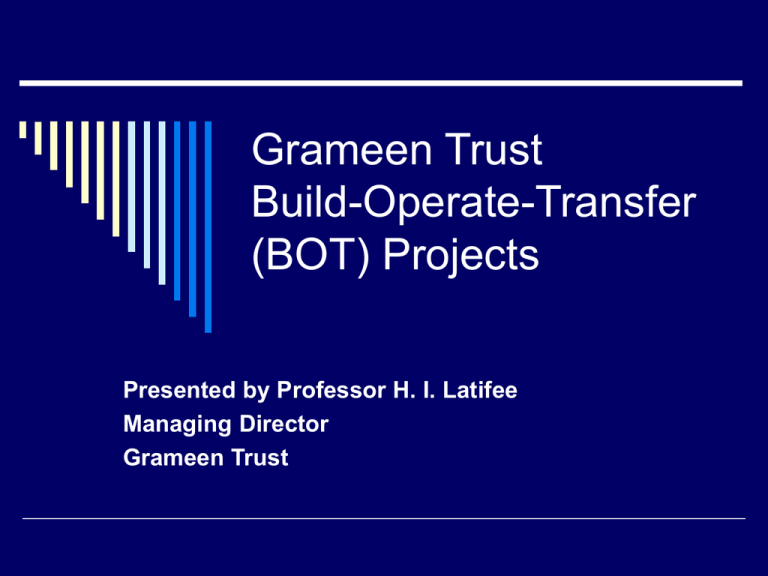
Grameen Trust Build-Operate-Transfer (BOT) Projects Presented by Professor H. I. Latifee Managing Director Grameen Trust Grameen Trust Established in 1989 by Nobel Laureate Professor Muhammad Yunus. Vision and Mission: Participants at Grameen Dialogue Program Grameen Trust is committed to the cause of poverty alleviation. It envisages a world free from poverty and hunger, where poverty will be a phenomenon of the past. Grameen Trust’s mission is to undertake any programs that will help eradicate poverty. As a part of its mission, it provides financial and technical support worldwide. It also directly implements microcredit programs in areas where there is no sustainable microcredit project for the poorest. 138 partners in 37 countries including BOT projects. Grameen Trust Programs Grameen Bank Replication Program: Through Partners Direct Implementation Joint Collaboration Program Tsunami Program Dignity Program Rehabilitation Program Other Programs: Dignity Program Members in Bangladesh Grameen Dialogue, Training, Workshop, Technical Assistance, Monitoring and Evaluation, Audit, Publication, Internship, Project Development, Networking, Library Services, Web site Grameen Bank Approach Grameen Bank was initiated as a challenge to the conventional banking which had no place for the poor. Began as the Grameen Bank Project in 1976. Established as a Bank in 1983. Promotes Credit as a Human Right. Grameen Bank gives collateral-free loans. It provides loans and financial services without any legally enforceable contact. It has preference for giving loans to women. Provides services at the door-step of the poor. Grameen Bank is owned by the poor borrowers. Grameen Bank Approach Loans can be received in a continuous sequence. All loans are to be paid back in regular installments. More than one loan can be received simultaneously. It comes with both compulsory and voluntary savings Replicated in more than 100 countries around the world. Professor Muhammad Yunus and Grameen Bank won 2006 Nobel Peace Prize. Professor Yunus and Ms. Taslima Begum with Nobel Peace Prize Why Grameen Bank Replication Program to Provide Microcredit for Poverty Alleviation Success of Grameen Bank in poverty alleviation. 64% of members of Grameen Bank have crossed the poverty line. Focus on women’s empowerment and enriching families. Grameen advocacy for promotion of microcredit as an effective tool for poverty alleviation. Grameen Trust’s support for MFIs to start microcredit programs. Global microcredit outreach to serve the poor: 1997: 7.6 million served 2005: 113 million served Opportunity for reaching billions of people living under the poverty line based on current coverage: Asia: 38% Africa & Middle East: 8.5% Latin America & the Caribbean: 11.6% Europe: 1.7% What is a BOT Project? A BOT is the direct implementation by Grameen Trust of the Grameen Bank Approach to setting up a microfinance program in a specific location. When there is a need for immediate and rapid implementation of a microfinance program to reach the poor people quickly, Grameen Trust deploys its own experienced Grameen staff to setup a microfinance program following the Build-Operate-Transfer (BOT) model. Why the BOT Approach? Cost effective implementation Fast membership mobilization Faster vertical and horizontal expansion On-the-job staff training reduces time and costs Faster program selfsustainability “Not reinventing the wheel” Center Meeting in Turkey Benefits of the BOT Approach For Members: Loan Disbursement in Guatemala Collateral free micro-loans for the poor Opportunities for income generating activities using microcredit Empowerment through financial freedom Peer group support Benefits of the BOT Approach For Staff: Staff Training in Turkey Transfer of Grameen technology and know how of microfinance operations Creates employment opportunities in local communities Capacity building of the local staff Opportunities for community service Grameen Trust BOT Projects Myanmar Kosovo Turkey Zambia Costa Rica Guatemala Indonesia A Borrower at Her Workshop in Zambia Myanmar In 1997 Grameen Trust was selected by Borrowers in Myanmar UNDP/UNOPS Asia Office to create and maintain the Sustainable Livelihood Through Microcredit for the Poor project in Myanmar. The project began in August 1997 in the Delta Zone of Myanmar. GT sent 6 senior Grameen staff to Myanmar to implement the microcredit project under its Build, Operate and Transfer (BOT) model. The project currently has more than 100 local staff and all international staff from Grameen have been withdrawn. After five years of developing a sustainable microfinance program at the grassroots level Grameen Trust handed over the project to the local management. It is now being managed by local staff who were trained by Grameen. Myanmar Project at a Glance Name Sustainable Livelihoods Through Microcredit for the Poor Year Established 1997 Donor Partners UNDP, UNOPS Asia Office Branches 13 [Delta Region] Members 109,038 Borrowers 87,228 Percentage Women 100% Loans Disbursed US$ 14,553,023 Savings Balance US$ 847,412 Repayment Rate 100% Status Operations handed over on May 17, 2002, after successful completion of the project on the BuildOperate-Transfer methodology. Update: Sept., 2006 Kosovo Grameen Trust initiated the Kosovo Grameen Mission Arcobaleno Microcredit Fund with financing provided by Mission Arcobaleno, which was a citizens’ fund, raised in Italy. Created specifically to assist the people with microcredit in Kosovo to generate self employment and rebuild their lives after the war in 1998. GT sent 6 senior Grameen staff to Kosovo to implement the microcredit project under its Build, Operate and Transfer (BOT) model. The project currently has 22 local staff and 2 international staff from Grameen. It has served more than 10,500 poor members with microcredit to help rebuild their lives Kosovo Project at a Glance Name Kosovo Grameen Missione Arcobaleno Microcredit Fund Year Established 2000 Donor Partners Missione Arcobaleno Branches 4 [Peje, Pristina, Gjilan and Prizren] Total Outreach 10,617 Current Members 6,027 Percentage Women 100% Loans Disbursed US$ 29,774,631 Savings Balance US$ 363,575 Repayment Rate 100% Status Operations on-going. [Borrowers: 5,843] Update: May, 2007 A Member at Her Store in Kosovo Turkey Grameen Trust initiated a BOT project in Diyarbakir in Southeastern Turkey at the invitation from the Turkish Foundation for Waste Reduction in 2003. Turkish Foundation for Waste Reduction selected Grameen Trust to implement a microcredit program in Turkey at a time when the country faced rising unemployment rates and when more than 20% of the people lived below the national poverty line, but had virtually no experiences of using microcredit as the instrument for poverty reduction. GT sent 3 senior Grameen staff to Turkey to implement the microcredit project under its Build, Operate and Transfer (BOT) model. The project currently has 43 local staff and 2 international staff from Grameen. In 2007 TGMP opened one new branch in Ankara, the capital of Turkey, with the aim of opening 5 more branches there. Turkey Project at a Glance Name Turkish Grameen Microcredit Project Year Established 2003 Donor Partners Turkish Foundation for Waste Reduction Branches 8 [Diyarbakir, Mardin, Batman, Silvan and Bismil], 1 [Ankara] Members 4,888 Borrowers 4,714 Percentage Women 100% Loans Disbursed US$ 4,580,127 Savings Balance US$ 170,881 Repayment Rate 100%% Status Operations on-going. Update: April, 2007 Center Meeting in Turkey Zambia Microfinance for Poverty Reduction Project Zambia (MPRP) aims to provide 2,400 poorest Zambians with microfinance services over a three year period in an effort to lift them out of poverty. GT sent 2 senior Grameen staff to Zambia to implement the microcredit project under its Build, Operate and Transfer (BOT) model. The project currently has 10 local staff and 2 international staff from Grameen. The project setup two branches: one urban branch in Zambian capital Lusaka, and a rural branch in Chongwe. First loan disbursement was in June 2005. In addition to the local staff, the managers from Grameen have also trained 10 Zambian national United Nations volunteers in the microcredit program. Zambia Project at a Glance Name Microfinance for Poverty Reduction Project Zambia Year Established 2004 Donor Partners UNV Branches 2 [Chongwe and Lusaka] Members 3,120 Borrowers 2,880 Percentage Women 100% Loans Disbursed US$ 639,844 Savings Balance US$ 100,505 Repayment Rate 100% Status Operations on-going. Update: May, 2007 Center Meeting in Zambia Costa Rica In December 2005 Grameen Trust begun a BOT project in Costa Rica with funding from the Whole Planet Foundation. The project is being implemented in Guacimo, Siquirres and Limon of Limon Provinces of Costa Rica. GT sent 5 senior Grameen staff to Costa Rica to implement the microcredit project under its Build, Operate and Transfer (BOT) model. The project currently has 10 local staff and 4 international staff from Grameen. The primary objective of the project is to reach 4500 members within the period of three years. The project has already disbursed US$ 4,208 to 26 borrowers, by the end of April 2006. The project enjoys 100% repayment rate. Costa Rica Project at a Glance Name Associacion Costa Rica Grameen (ACRG) Year Established 2005 Donor Partners Whole Planet Foundation Branches 3 [Guacimo, Siquirres and Limon] Members 2,137 Borrowers 1,961 Percentage Women 100% Loans Disbursed US$ 452,859 Savings Balance US$ 21,550 Repayment Rate 100% Status Operations on-going. Update: May, 2007 Loan Disbursement in Costa Rica Guatemala The Asociacion Civil Guatemalteca Grameen Credit is a BOT project of Grameen Trust. It was set up in December 2005 with financial assistance from the Whole Planet Foundation, USA, to implement microcredit program in Guatemala to meet the challenges of poverty alleviation. GT sent 5 senior Grameen staff to Guatemala to implement the microcredit project under its Build, Operate and Transfer (BOT) model. The project currently has 11 local staff and 5 international staff from Grameen. The project is being implemented in the counties around Lake Atitlan. Guatemala Project at a Glance Name Asociacion Civil Guatemalteca Grameen Credit Year Established 2006 Donor Partners Whole Planet Foundation Branches 3 [Panajachal, Nahuala and San Lucas] Members 4,515 Borrowers 3,954 Percentage Women 100% Loans Disbursed US$ 665,353 Savings Balance US$ 43,193 Repayment Rate 100% Status Operations on-going. Update: May, 2007 Center Meeting in Guatemala Indonesia Grameen Trust took initiatives to setup a BOT project in Aceh, Indonesia, the region hardest-hit by the Tsunami, in an effort to help rebuild the lives of the survivors. Sister Beth del Fierro, of the Daughters of St. Anne, who became inspired by Professor Muhammad Yunus and the Grameen approach, helped raise the funds for this project. A major portion of the funds were raised from her friends, Community Health Care Center and the Committee of German Doctors. The Aceh Grameen Credit Project began operations in August 2006. GT sent 1 senior Grameen staff to Indonesia to implement the microcredit project under its Build, Operate and Transfer (BOT) model. The project currently has 4 local staff and 1 international staff from Grameen. Indonesia Project at a Glance Name Aceh Grameen Credit Project Established 2006 Partners Grameen Aceh Women’s Loans and Savings Cooperative, Committee of German Doctors, Community Health Care Center Branches 1 [Banda Aceh] Members 595 (100% Women) Borrowers 532 Loans Disbursed US$ 59,333 Savings Balance US$ 4,323 Repayment Rate 99% Status Operations on-going. Update: May, 2007 Future BOT Projects Bahrain Cameroon China: Crafts at a Stall Set up by Members of a Productive Family in Bahrain Sichuan Province Inner Mongolia Province Colombia East Timor India Nicaragua Paraguay Tanzania Other Countries Conclusion Grameen Trust BOT Programs reach the very poor with microfinancial services. Cost-effective approach to setting up worldclass microfinance institutions. Demonstrated success in initiating microfinance operations in regions where there were no MFI worth the name. Successful sustainable microfinance operations in both post conflict and crisis regions, as well as pockets of poverty in other countries. Thank You For more information please visit our website: www.grameen.com/grameen/gtrust
